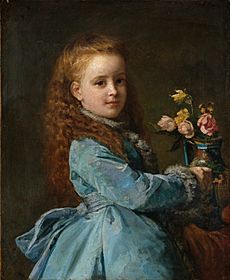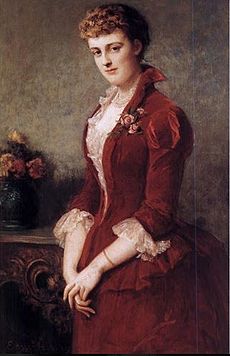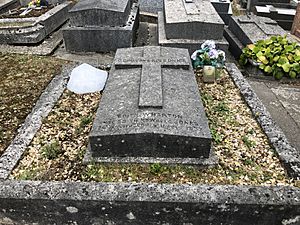Edith Wharton facts for kids
Quick facts for kids
Edith Wharton
|
|
|---|---|
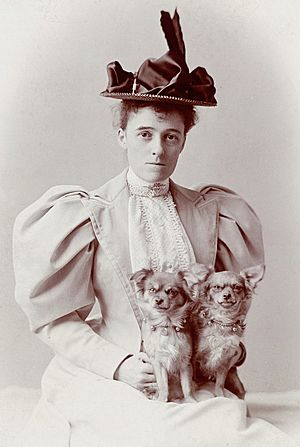
Wharton c. 1895
|
|
| Born | Edith Newbold Jones January 24, 1862 New York City, U.S. |
| Died | August 11, 1937 (aged 75) Saint-Brice-sous-Forêt, France |
| Resting place | Cimetière des Gonards, Versailles, Yvelines, France |
| Occupation |
|
| Notable awards | Pulitzer Prize for Fiction 1921 The Age of Innocence |
| Spouse |
Edward Robbins Wharton
(m. 1885; div. 1913) |
| Signature | |
Edith Wharton (born Edith Newbold Jones; January 24, 1862 – August 11, 1937) was an American writer and designer. She used her deep knowledge of New York's wealthy families to show what life was like during the Gilded Age. This was a time in the late 1800s when some people became very rich, but there were also many social problems. In 1921, Edith Wharton became the first woman to win the Pulitzer Prize for Fiction. She won it for her novel The Age of Innocence. This prize is one of the most important awards for writers in the United States. In 1996, she was honored in the National Women's Hall of Fame. Some of her other famous books include The House of Mirth, the shorter novel Ethan Frome, and several spooky ghost stories.
Biography
Early life and family
Edith Newbold Jones was born on January 24, 1862, in New York City. Her parents were George Frederic Jones and Lucretia Stevens Rhinelander. She had two older brothers, Frederic and Henry.
Edith's father's family, the Joneses, were very rich and important. They made their money from real estate. The saying "keeping up with the Joneses" (meaning trying to have as much as your neighbors) is thought to be about her father's family. Her mother's great-grandfather, Ebenezer Stevens, was a hero in the American Revolutionary War.
Edith was born during the American Civil War. However, her family traveled to Europe after the war because American money was worth less. From 1866 to 1872, the Jones family visited France, Italy, Germany, and Spain. During these trips, young Edith learned to speak French, German, and Italian very well. When she was nine, she got very sick with typhoid fever while in Germany.
After returning to the United States in 1872, they spent winters in New York City and summers in Newport, Rhode Island. Edith was taught by private teachers. She did not like the strict rules for fashion and manners that young girls were expected to follow. These rules were meant to help girls marry well. Edith thought these rules were not important and felt like a burden. She wanted more education than she received. So, she read many books from her father's library and his friends' libraries. Her mother told her not to read novels until she was married, and Edith followed this rule.
Starting to write
Edith Wharton loved to write and tell stories from a young age. When her family moved to Europe, she started "making up" stories. She would walk with an open book, turning pages as if reading, while making up a story for her family. She began writing poetry and stories as a young girl. At age 11, she tried to write her first novel. But her mother's criticism made her stop trying, and she focused on poetry instead.
When she was 15, her first published work appeared. It was a translation of a German poem. She was paid $50 for it. Her family did not want her name printed because writing was not seen as a proper job for women from important families. So, the poem was published under a friend's father's name.
In 1877, at 15, she secretly wrote a short novel called Fast and Loose. In 1878, her father arranged for a collection of her poems to be privately published. Wharton published a poem using a fake name in the New York World in 1879. In 1880, five of her poems were published without her name in Atlantic Monthly, an important literary magazine. Even with these early successes, her family and friends did not really support her writing. She kept writing but did not publish anything more until 1889.
Social life and marriage
Between 1880 and 1890, Wharton spent time on social events in New York's upper class. She carefully watched the changes happening around her. She later used these observations in her writing.
In 1885, at age 23, Wharton married Edward Robbins (Teddy) Wharton. He was 12 years older than her. He came from a well-known Boston family. He enjoyed sports and travel, just like her. The Whartons lived in Newport, Rhode Island, and later bought a house called Land's End. They also bought a home in New York City. From 1886 to 1897, they traveled overseas often, visiting Italy, Paris, and England. After her marriage, three things became very important to Wharton: American houses, writing, and Italy.
From the late 1880s until 1902, Teddy Wharton suffered from long-term depression. Because of this, they stopped their extensive travels. His depression became worse, and they lived mostly at their estate, The Mount, in Lenox, Massachusetts. During these years, Edith Wharton also had asthma and periods of depression.
In 1908, doctors said Teddy Wharton's mental condition could not be cured. Edith Wharton divorced Edward Wharton in 1913, after 28 years of marriage. Around the same time, some writers who focused on "naturalism" criticized her work.
Besides novels, Wharton wrote at least 85 short stories. She was also a talented garden designer and interior designer. She wrote several books about design, including her first major published work, The Decoration of Houses (1897). Another of her design books was Italian Villas and Their Gardens (1904), which had beautiful illustrations.
Travels and life abroad

Edith Wharton crossed the Atlantic Ocean 60 times in her life. In Europe, she mostly visited Italy, France, and England. She also went to Morocco. She wrote many books about her travels, such as Italian Backgrounds and A Motor-Flight through France.
Her husband, Edward Wharton, also loved to travel. For many years, they spent at least four months each year abroad, mainly in Italy. In 1888, the Whartons took a cruise through the Aegean islands. Edith was 26. She kept a travel journal during this trip, which was later published as The Cruise of the Vanadis. This is considered her earliest known travel writing.
In 1897, Edith Wharton bought Land's End in Newport, Rhode Island. She described the main house as "incurably ugly." She paid $80,000 for the property and spent thousands more to change the house's outside, decorate the inside, and design the gardens.
In 1902, Wharton designed The Mount, her estate in Lenox, Massachusetts. This house still exists today and shows her design ideas. She wrote several of her novels there, including The House of Mirth (1905). At The Mount, she hosted important American writers, including her close friend, Henry James. He called her estate "a delicate French chateau mirrored in a Massachusetts pond." The Mount was her main home until 1911. When she lived there or traveled, her longtime driver, Charles Cook, often drove her. When her marriage ended, she decided to move to France permanently. She first lived in an apartment in Paris.
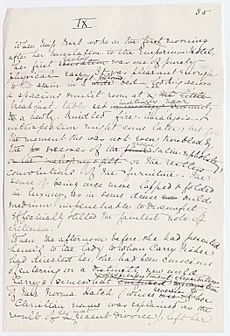
Wharton was getting ready for a summer vacation when World War I started. Many people left Paris, but she moved back to her apartment there. For four years, she worked very hard to support France's war efforts. In August 1914, she opened a workshop for women who had lost their jobs. They were fed and paid. This started with 30 women and soon grew to 60.
When Germans invaded Belgium in late 1914, many Belgian refugees came to Paris. Edith helped set up the American Hostels for Refugees. These hostels provided shelter, food, and clothes. They also helped refugees find jobs. She raised over $100,000 to help them. In early 1915, she started the Children of Flanders Rescue Committee. This group helped nearly 900 Belgian children who had fled their bombed homes.
Because of her important friends in the French government, she and her friend Walter Van Rensselaer Berry were among the few foreigners allowed to visit the front lines during World War I. They made five trips between February and August 1915. Wharton wrote about these trips in articles that were later published as Fighting France: From Dunkerque to Belfort. This book became a bestseller in America. Traveling by car, Wharton and Berry drove through the war zone, seeing many destroyed French villages. She visited the trenches and heard artillery fire.
Throughout the war, she worked tirelessly for refugees, injured people, and those who had lost their homes or jobs. She was a "heroic worker" for her adopted country. On April 18, 1916, the President of France gave her the Legion of Honour. This is France's highest award, given for her dedication to the war effort. Her relief work included setting up workshops for unemployed French women, organizing concerts for musicians, raising a lot of money for the war, and opening hospitals for people with tuberculosis.
In 1915, Wharton edited a book called The Book of the Homeless to raise money for charity. It included writings, art, poetry, and music from many famous European and American artists. She suggested the book to her publisher, arranged everything, found contributors, and translated the French parts into English. She also kept writing her own novels, short stories, and poems. She wrote for The New York Times and kept up her huge amount of letters. Wharton urged Americans to support the war and encouraged America to join it.
When the war ended, she watched the Victory Parade from a friend's balcony in Paris. After four years of intense work, she decided to leave Paris for the quiet countryside. Wharton settled about 10 miles north of Paris in Saint-Brice-sous-Forêt. She bought an 18th-century house on seven acres of land, which she called Pavillon Colombe. She lived there in summer and autumn for the rest of her life. She spent winters and springs on the French Riviera.
Wharton strongly supported French imperialism, calling herself a "rabid imperialist." The war made her political views even stronger. After the war, she traveled to Morocco. She wrote a book called In Morocco, praising the French government there.
In the years after the war, she divided her time between Hyères and Provence. There, she finished The Age of Innocence in 1920. She only returned to the United States once after the war. This was in 1923, to receive an honorary degree from Yale University.
Later years and death
The Age of Innocence (1920) won the 1921 Pulitzer Prize for Fiction. This made Wharton the first woman to win this award. She was also nominated for the Nobel Prize in Literature in 1927, 1928, and 1930.
Wharton was a friend and trusted helper to many important thinkers of her time. Henry James, Sinclair Lewis, Jean Cocteau, and André Gide all visited her. Theodore Roosevelt was also a valued friend. She spoke French, Italian, and German very well. Many of her books were published in both French and English.
In 1934, Wharton's autobiography, A Backward Glance, was published.
On June 1, 1937, Wharton was at her French country home. She was working on a new edition of The Decoration of Houses when she had a heart attack.
She died from a stroke on August 11, 1937, at her 18th-century house, Le Pavillon Colombe, in Saint-Brice-sous-Forêt, France. She was buried in the American Protestant section of the Cimetière des Gonards in Versailles, France. She was buried "with all the honors owed a war hero and a chevalier of the Legion of Honor."
Writing
Career as a writer
Even though she did not publish her first novel until she was forty, Wharton became a very productive writer. She wrote 15 novels, seven novellas (shorter novels), and 85 short stories. She also published poetry, books on design, travel, and literary criticism. She also wrote a memoir about her own life.
In 1873, Wharton wrote a short story and gave it to her mother. Her mother's criticism made her decide to write only poetry. She often wanted her mother's approval, but rarely received it. Their relationship was difficult. Before she was 15, Wharton wrote Fast and Loose (1877). In her youth, she wrote about society. Her main ideas came from her experiences with her parents.
In 1889, she sent three poems to different magazines. Her poem "The Last Giustiniani" was published in Scribner's Magazine. It was not until Wharton was 29 that her first short story, "Mrs. Manstey's View," was published. It was not very successful. She completed "The Fullness of Life" after a trip to Europe. This story, like many others, talks about her marriage.
In 1901, Wharton wrote a two-act play called Man of Genius. It was practiced but never performed. Another play from 1901, The Shadow of a Doubt, was thought to be lost until it was found in 2017. Its first performance was on BBC Radio 3 in 2018. One of her earliest literary projects was translating a German play in 1902.
Many of Wharton's novels use dramatic irony. This means the reader knows something that the characters in the story do not. She grew up in wealthy society in the late 1800s. She became one of its sharpest critics in books like The House of Mirth and The Age of Innocence.
Main ideas in her writing
Versions of her mother often appeared in Wharton's stories. One writer called it "one of the most lethal acts of revenge ever taken by a writing daughter." In her memoir, Wharton described her mother as lazy, wasteful, critical, and cold.
Maureen Howard, an editor of Wharton's stories, points out several ideas that appear often in her short stories. These include feeling trapped and trying to be free, the writer's own morals, and showing the truth behind appearances. Wharton's writing also looked at "social rules and changes" related to the "extremes and worries of the Gilded Age." These ideas were also in her ghost stories. In these stories, ghosts often show human cruelty.
A key idea in Wharton's writing is the connection between a house and the feelings of the people who live in it. Maureen Howard says, "Edith Wharton thought of houses... as places of shelter and loss. Houses – their limits and their dramatic possibilities…they are never just backgrounds."
What influenced her writing
As a child, Edith Wharton was not allowed to read American children's stories that used slang. This included popular authors like Mark Twain. She could read Louisa May Alcott but preferred Lewis Carroll's Alice's Adventures in Wonderland. Wharton said her mother forbade her from reading many novels until she was married.
Instead, Wharton read classic books, philosophy, history, and poetry from her father's library. These included works by Daniel Defoe, John Milton, Victor Hugo, and Lord Byron. One biographer said Wharton read herself "out of Old New York." Her influences also included thinkers like Herbert Spencer and Charles Darwin. These thinkers helped her write novels that studied society like a scientist. Wharton also developed a strong love for the poet Walt Whitman.
Works
Novels
- The Valley of Decision, 1902
- The House of Mirth, 1905
- The Fruit of the Tree, 1907
- The Reef, 1912
- The Custom of the Country, 1913
- Summer, 1917
- The Marne, 1918
- The Age of Innocence, 1920 (Pulitzer Prize winner)
- The Spinster, 1921
- The Glimpses of the Moon, 1922
- A Son at the Front, 1923
- The Old Maid, 1924
- The Mother's Recompense, 1925
- Twilight Sleep, 1927
- The Children, 1928
- Hudson River Bracketed, 1929
- The Gods Arrive, 1932
- The Buccaneers, 1938 (unfinished)
Novellas and novelette
- The Touchstone, 1900
- Sanctuary, 1903
- Madame de Treymes, 1907
- Ethan Frome, 1911
- Bunner Sisters, 1916
- Old New York, 1924
- 1. False Dawn; 2. The Old Maid; 3. The Spark; 4. New Year's Day
- Fast and Loose: A Novelette, 1938 (written in 1876–1877)
Poetry
- Verses, 1878
- Artemis to Actaeon and Other Verse, 1909
- Twelve Poems, 1926
Short story collections
- The Greater Inclination, 1899
- Crucial Instances, 1901
- The Descent of Man and Other Stories, 1904
- The Hermit and the Wild Woman and Other Stories, 1908
- Tales of Men and Ghosts, 1910
- Xingu and Other Stories, 1916
- Here and Beyond, 1926
- Certain People, 1930
- Human Nature, 1933
- The World Over, 1936
- Ghosts, 1937
- Roman Fever and Other Stories, 1964
- Madame de Treymes and Others: Four Novelettes, 1970
- The Ghost Stories of Edith Wharton, 1973
- The Collected Stories of Edith Wharton, 1998
- The New York Stories of Edith Wharton, 2007
Non-fiction
- The Decoration of Houses, 1897
- Italian Villas and Their Gardens, 1904
- Italian Backgrounds, 1905
- A Motor-Flight Through France, 1908
- The Cruise of the Vanadis, 1910
- Fighting France: From Dunkerque to Belfort, 1915
- French Ways and Their Meaning, 1919
- In Morocco, 1920 (travel)
- The Writing of Fiction, 1925
- A Backward Glance, 1934 (autobiography)
- Edith Wharton: The Uncollected Critical Writings, 1996
- Edith Wharton Abroad: Selected Travel Writings, 1888–1920, 1995
As editor
- The Book of the Homeless, 1916
Adaptations of her works
Films
- The House of Mirth, a 1918 silent film (now lost).
- The Glimpses Of The Moon, a 1923 silent film (now lost).
- The Age of Innocence, a 1924 silent film (now lost).
- The Marriage Playground, a 1929 talking film based on The Children.
- The Age of Innocence, a 1934 film.
- Strange Wives, a 1934 film based on her short story Bread Upon the Waters (now lost).
- The Old Maid, a 1939 film starring Bette Davis.
- The Children, a 1990 film.
- Ethan Frome, a 1993 film starring Liam Neeson.
- The Age of Innocence, a 1993 film directed by Martin Scorsese.
- The Reef, a 1999 film.
- The House of Mirth, a 2000 film starring Gillian Anderson.
Television shows
- The Touchstone, a live TV show in 1951.
- Ethan Frome, a 1960 TV show.
- Looking Back, a 1981 TV show based on her life.
- The House of Mirth, a 1981 TV show.
- The Buccaneers, a 1995 BBC mini-series.
Theater plays
- The House of Mirth was made into a play in 1906 by Edith Wharton herself and Clyde Fitch.
- The Age of Innocence was made into a play in 1928.
Ballets
- Ethan Frome was adapted into a ballet called Snowblind in 2018.
Images for kids
See also
 In Spanish: Edith Wharton para niños
In Spanish: Edith Wharton para niños


